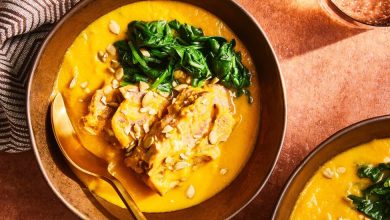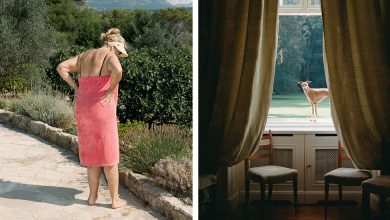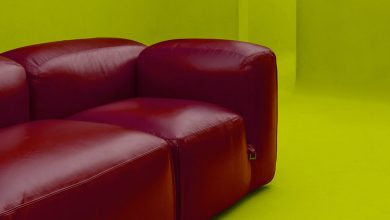Jaune Quick-to-See Smith Maps New Meanings

As a child growing up on the Flathead Reservation in Montana, Jaune Quick-to-See Smith was “like a magnet,” she said, constantly picking up whatever information might help her make sense of the world. It was not an easy world to understand: Born in 1940, she had “a dystopian childhood,” she told me recently from her home near Albuquerque, N.M. Her father worked as a horse trader, her mother left when she was two and the artist, now 81, spent her early years toiling in fields alongside Filipino migrants and Japanese Americans who’d been recently released from internment camps, cutting rhubarb in tar paper sheds each winter, picking strawberries and raspberries in the spring and harvesting string beans in the fall.
When she was 7, Smith began hiding in trees to read anything and everything she could borrow from a bookmobile that occasionally passed through town. It was an escape from her work, but not always from the bitter realities of living through an ongoing American genocide. “The stories in Steinbeck told me what was going to happen to me when I was older,” she said to me. “Knowing what I faced in my future, I even thought about suicide in my teens, which is very common for Native people … we were people who were lost and just grasping.”
Instead, she found inventive and incisive ways to critique how power and hegemony work on canvas, using materials ranging from charcoal and acrylic paints to newspaper print and other text elements.But first she had to walk through doors that were meant to be closed to her, with white gatekeepers doing all they could to hold her back — in high school, a guidance counselor suggested vocational courses because, he said, “Indians don’t go to college.” Then, after Smith did just that, first at Olympic College in Washington and then at Framingham State University in Massachusetts, she was discouraged from applying to the M.F.A. program at the University of New Mexico. “In the art department, they said, ‘Indians go to art ed, you can’t go to fine arts,’ ” she told me. “Because Indians do crafts.” Unmoved by the sort of discouragement she’d already heard, Smith took classes there anyway, ultimately spending four years accumulating credits. Along the way, she met other American Indian artists, people like Emmi Whitehorse and Ed Singer, and formed the Grey Canyon Artists collective.
The art world, by contrast, was somewhat more accepting of Smith’s ambitions. In 1979, she joined New York’s Kornblee Gallery after the painter Susan Crile bought some of her work and arranged a meeting between Smith and Jill Kornblee. The following year, after her first solo exhibition at Kornblee received media attention from Art in America and the Village Voice, Smith left the University of New Mexico with an M.A. in visual arts. Three of her abstract pastel, charcoal and graphite pencil on paper pieces from this period are now in thepermanent collection of the Whitney Museum of American Art. Even without the strong use of text that has defined so much of Smith’s work since, they call to mind Kandinsky set loose on the American plains, betraying an already highly evolved style and worldview.
In the subsequent decades, Smith had many more shows and continued to hone and deploy her distinct visual language, one infused with a Pop Art sensibility that often situates the symbols of American empire and Native life alongside one another to striking effect. “Spam” (1995), for instance, suggests centuries of lost food traditions through the simple outline of a buffalo painted on a canvas collaged with newspaper clippings, with the title of the work spelled out beneath its hoof. “Gifts for Trading Land With White People” (1992) incorporates a canvas similarly plastered with pieces of newspaper and inscribed with the image of a canoe. Above the canvas hangs a range of sports memorabilia (baseball caps, bumper stickers) from real sports teams with Native American names or mascots. And in “State Names” (2000), a multicolored map of the United States seems to ooze with dripping paint that obscures the few state and territory names that didn’t stem from Indigenous sources.
Smith’s new body of work, “Indigenizing the Colonized U.S. Map,” 12 large-scale mixed-media paintings that form the majority of “Woman in Landscape,” on view now at the Garth Greenan Gallery in New York, is a continuation of her decades-long interest in maps. These canvases feature different renderings of a U.S. map turned on its side, awash in color and plastered with text and other collage elements that highlight the disorienting effect of being handed a map of your home by the person who has stolen it from you. “A map is not an empty form for me, it’s not an icon of this incredible country,” the artist told me. “It’s not just a vacant idea, it’s real. It’s about real land — stolen land, polluted land.” When she looks at a map, she sees the many reservations she’s visited and the many people she’s known on them. She sees bloodshed, oil pipelines; she sees the climate disaster brought about by the plundering of resources. And, at the same time, she sees the miracle that is our continued existence as American Indians.
“I think I’m a miracle and I say that whenever I talk to an audience,” Smith said. “I tell them: ‘I’m a miracle, and any Native person here is a miracle.’ And I say that to you, Joshua — the fact that you are here talking to me is a miracle.” Below, her answers to T’s Artist’s Questionnaire.
What is your day like? What’s your work schedule?
It includes a lot of administrative work, like answering requests for reference letters from young Natives, and dealing with questions from museums that still write and ask things like “Do you know any Native American artists?” even though there are half a dozen that are in the news all the time. In this book I’m working on [for Thames & Hudson], I hope to feature 250 contemporary Natives, and I could double that number easily. So that’s part of my day. And then the other part is working here in my studio or doing things with my granddaughters.
What does your studio look like?
One wall is covered with supplies, which I’ve collected over the years because [the artist] Fritz Scholder told me one time, “Don’t ever run out of paint and don’t ever run out of canvases.” So I’ve tended to always order more than what I need. In the next room is a big library of books. I have a lot of books because, since childhood, I’ve always valued them. And then there are always multiple works underway here.
Could you tell me about the benefits of having a library next to your studio?
Because I’m a chameleon in a sense, I’ll be working on a painting and think, “Oh, I need to get my books of plateau pictographs out,” then I’ll rummage through my library and pull out what I need. I’ve got a dozen books that I pulled out before I started drawing my mother earth figure here, “Woman in Landscape” (2021). I’ll look things up, then go to work and scramble it all up and make my own thing out of it.
When you start a new piece, where do you begin?
I often begin with an idea, a very general idea, like maps. I’ve done maps before, but they’ve always been horizontal, like maps would normally be. That was my plan with these maps here, behind me, but then I stood them up to get them out of the way and I saw how it really changes the shape of the map — it becomes an organic thing, like a side of beef. It’s kind of creepy. And then I thought about that, and about what else I could do to that map, and got the idea that maybe I could put some beadwork designs or something on part of it. So I did a little bit of that and it scared me, so I stopped and worked on some other stuff, then came back to it and thought, “Yeah, that’s really kind of weird.” I have to grow into it when I do something like that.
And how do you know when you’re done?
Generally, I get it to a place where I think it might be done and then I’ll wait awhile before leaving it at that. You know, it’s like when you’re writing something and you leave it for a while and come back to it and, suddenly, you can see all the things that you need to fix. At that point you’re pretty sure that it’s probably OK. Then, of course, I’ve got my son, Neal Ambrose-Smith, who is an incredible artist, and I’ll call him up and invite him to come over and take a look.
What’s the first work you ever sold? And how much did you sell it for?
I think it was a pastel, back in the early ’70s, for maybe $45.
How many assistants do you have?
None. I mean, my son is generous and kind and he’s helping me with this butterfly mask because he’s an incredible fabricator. But he’s an artist in his own right, not an assistant. So I don’t have one, but I wish I did. I am very blessed, though. A couple of times I’ve had people come to help me straighten up a bit because I tend to clutter, and if I’m in desperate straits and have to show somebody the studio my son will come over and help neaten things up for me.
What music do you play when you’re making art?
Often it’s quiet in here, but I love Native flute music. I love Spanish guitar. I love Bach a lot. Those are my go-tos.
Is there a meal that you eat on repeat when you’re working?
I eat a lot of beans and rice. I’m a vegetarian, so I eat a lot of salad, and my granddaughters will eat that with me.
When did you first feel comfortable saying you’re a professional artist?
I didn’t think of myself as worthy of that title for a long time, even after I’d sold work. I had no idea where it was going. I know now from teaching that white students are filled with agency and say that they’re an artist, that they’re going to New York, that they’re going to get in a gallery. And I’m amazed at that because I can tell you that when I was going through that part of my journey, I did not ever think that any of these things were going to happen. I just stumbled into them, then wondered, “How did I get here? If somebody finds out that I’m really not worthy of this, they’re going to tell other people.”
When I served on the College Art Association board I was the first Native to do that. I’ve been the first Native to do a lot of stuff, and each time I’m thinking, “How did I get here?” I still remember people talking about their parents taking them to Europe on their summer vacations, and meanwhile I wasn’t inside of a museum until I was in my 20s.
How often do you talk to other artists?
I talk to my son every other day or every few days. A lot of times, if I’m lonely, I’ll call him up just to talk about art. And if I can get out to something, which we haven’t been able to do because of Covid, I’ve got some Native girlfriends that are my age in Santa Fe: Linda Lomahaftewa, who is Hopi and Choctaw, and Karita Coffey. They’ve been my friends for 40 years. I love to get together with them and talk Indian politics and Native art.
What’s your worst habit?
I gave up booze in the late ’70s because so many of my family members had died from it. And then I continued to smoke but gave that up in the mid-90s. Those were really my worst habits, but I keep working on improving myself.
What are you reading right now?
Joan Didion. I’ve got a pile of maybe eight Native writers on my night stand, like Heid Erdrich, Louise Erdrich, a guy named Hobson. And I must have four Joy Harjo books there, too, because I love her poetry. But I was reading some writer’s biography and they said that Joan Didion had the biggest impact on them, so I got “Slouching Towards Bethlehem” (1968) and I’m around halfway through it.
What is your favorite artwork by someone else?
I love Philip Guston for his storytelling and his painting, and the reason I’m drawn to his work is because it’s the stories of the Jews and how they fled the Holocaust. That story resonates with me. And then James Ensor, who made all those political paintings. He had a retrospective in New York and I flew to New York just to see it. I stayed all day in the museum studying his work and then flew back home at midnight. Goya is another one, especially his work about war. His “Los Caprichos” (published in 1799) is just stunning.
What’s the weirdest object in your studio?
I’ve got a sculpture here that’s actually affected several paintings or drawings I’ve done. It’s a Mexican sculpture I found in a secondhand shop in Albuquerque’s Old Town and it didn’t have a base, so I just put a little piece of wood under the feet here. It may not actually be from Mexico, it could be from here. There was no name on it. But it speaks to me — about oppression, imperialism, hegemony.
This interview has been edited and condensed.





